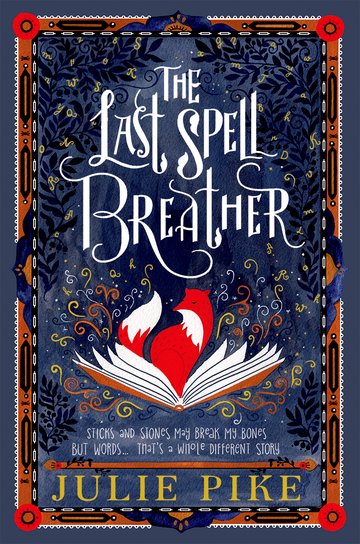
‘It’s a magical must-read that takes place in such an original, chapter-turning and cleverly-imagined world I didn’t want to leave behind. With The Last Spell Breather, Julie doesn’t just write about magic, she writes with a special kind of magic; as if her pen is gold-tipped.’
Rating: ⭐⭐⭐⭐⭐
Title: The Last Spell Breather
Author: Julie Pike (@Juliepike)
Illustrator: Dinara Mirtalipova (Website)
Publisher: Oxford University Press Children’s (@OUPChildrens)
Page count: 304
Date of publication: 4th July 2019
Series status: N/A
ISBN: 978-0192771605
Perfect for Year 4, Year 5 and Year 6.
#3Words3Emojis:
1. Magic ✨
2. Fox 🦊
3. Words 👄
Enter the unique world of the Spell Breathers!
Spell Breathing does not come naturally to Rayne – she loathes the hours of practice, the stacks of scrolls, and the snapping mud grotesques that cover her mother’s precious spell book. When she holds the spell book over a fire, it is only meant as an empty threat – until she feels the grotesque’s tiny teeth biting into her finger and lets go. In one clumsy move, her mother’s spells are broken, her village is plunged into danger, and an incredible adventure begins…
Review: I often think if only I had some way of transforming myself to be able to do something else. I often think about magic. I think we all often think about magic. But within the pages of this very special story, magic comes to life in an equally special way. Breathed to life. By the name of spells. Spells with a capital S. Spells that are strong and wrap around you and which possess a magic of their very own. However should those words come out in the wrong order or be directed in the wrong direction, then these Spells can cause a chaos of their very own too. And for the sometimes-creator of that chaos, let’s meet Rayne…
With the title of Spell Breather’s apprentice bestowed upon her ever since her mother decided to take her out of school (and almost away from her friends!), the world of spell breathing is not one Rayne is familiar with. Sometimes bungling and with a lack of self-confidence but often with her head elsewhere like wanting to play with her friends which reminded me of The Worst Witch meeting Luna Lovegood, she feels that she doesn’t have the same way with words that her magical mother, who is at the call of the community to help them, does.
You see, Rayne’s mother has been at this spell-breathing skill for some time. Not only does she service the locals with her powers but she also preserves the barrier that is keeping their town, Penderin, safe. However when an unexpected visitor arrives at the barrier, something is amiss and Rayne’s mother has to leave, meaning that Rayne has to learn quickly to look after herself and her town.
After speaking to Julie and hearing about her being from Wales, I’m sure I spotted more than a few Welsh references which resonated especially well with me. It’s a magical must-read that takes place in such an original, chapter-turning and cleverly-imagined world I didn’t want to leave behind. With The Last Spell Breather, Julie doesn’t just write about magic, she writes with a special kind of magic; as if her pen is gold-tipped.
‘It’s a magical must-read that takes place in such an original, chapter-turning and cleverly-imagined world I didn’t want to leave behind. With The Last Spell Breather, Julie doesn’t just write about magic, she writes with a special kind of magic; as if her pen is gold-tipped.’
I’m so pleased to welcome Julie Pike to The Reader Teacher today with her awe-inspiring and life-affirming blog post about the wondrous adventures she has been on that have influenced the writing of The Last Spell Breather…
When I set out to write The Last Spell Breather, I knew I wanted to create a magical page turning adventure. What I didn’t know was how to go about it. I went to see Garth Nix talk at the Hay Festival. It was my first ever author talk, and it was wonderful. One thing he said stood out like a beacon… ‘I learned how to write’.
I spent the next decade learning how to write my ‘page turner’, wrapping my head around plot, character arcs, pacing, story beats, magic systems and a whole lot more. I’m not done yet, I still have much learning to do.
Along the way, I realised there was one aspect of story I already knew inside out and back to front. I already knew that the best adventures were filled with high stakes and personal challenges. How did I know? Because the stories I’d devoured as a child had inspired me to have real-life adventures of my own.
Here’s a taste of my adventures, along with some grainy, pre-smart phone pictures, for good measure.
Wondrous Adventures
I’ve adventured overland through India, Nepal, Tibet and China. I left the UK on my own and made friends along the way. We slept on trains and visited friendly elephant reserves. We sailed down the Ganges to beautiful Varanasi. We slept in tents on the high plains and under the stars in the deserts. We journeyed to Everest’s mighty North Face and slept at Rongbuck monastery. We cleared road blocks in Lhasa, even pushing aside a police car with two coppers inside (thankfully they didn’t mind!). We ordered food in restaurants by pointing at other people’s dishes, because the only language we shared was smiling and laughter. We climbed mountains, and on the last night, we climbed to an abandoned part of the Great Wall of China and camped in a dazzling lightning storm.

Yes, my hair really was that red
Hard Work Adventures
My hardest adventure was climbing Kilimanjaro. The peak is 5,895 metres and a three-day hike from the park entrance. The higher you climb, the colder it gets and the water in your bottle freezes. The altitude makes it tricky to get a good night’s sleep and makes you feel queasy, so you don’t feel like eating. Closer to the top you’ll get a headache and may drop out, because it’s just too darn hard.
The final push begins at 11pm at night, where you climb the steep scree slope under a star filled sky. The idea is to be at the top for sunrise. It sounds wondrous, but by this point all you can think about, for hours and hours, is putting one foot in front of the other.
I didn’t make the top at sunrise, I was about 100 metres below. I sat on a rock and watched the sun crest the horizon, mesmerised by its red, orange and golden glory. By that point I was empty. I couldn’t go on. And I was sure I had no energy to get down either. Did Kilimanjaro have mountain rescue?
But I was wrong. I did have more. My guide, Arbogast said, ‘you can give up if you’re tired, but you’ve come from Europe to climb this mountain.’
Talk about the power of words! I picked myself up and staggered-crawled to the crater’s rim.

Me and Arbogast, I wouldn’t have made it without his support.
Leap of Faith Adventures
I’ve ridden white water in Chile, tandem-sky dived over the Great Lake of New Zealand and abseiled down a 100-foot freezing waterfall in France. None of these are skills I possess myself, they’re all borrowed from other people. Before each activity I feel sick with nerves and ‘what ifs.’ But I’ve done my research, I know my guides are experts, so I follow their instructions and take a leap of faith into adventure!
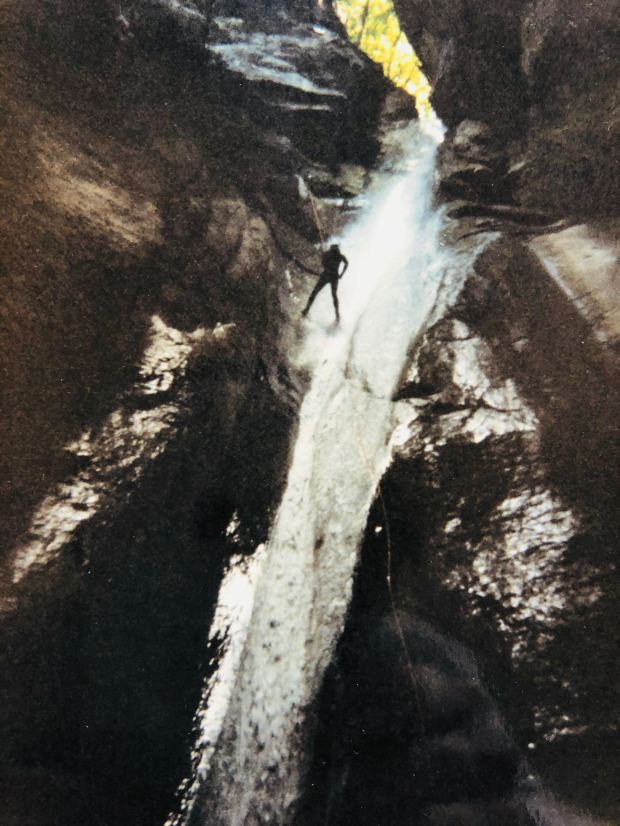
Come on in! The water’s lovely.
And then there are the adventures where you have no guide, you’re on your own, it’s totally down to you and there are no grainy pictures – because when you’re in a REAL adventure, the stakes are too high to stop and pose.
If you want to know about that one, come by an event or signing table and ask.
I try to bring all my adventures into my writing. I hope I’ve succeeded. I hope you enjoy The Last Spell Breather, and it inspires you (just like the stories I read as a child) to have adventures of your own.
Happy reading. Happy writing. Happy adventuring!

Julie Pike – Biography
Julie grew up on a council estate, nestled between the forests and foothills of the Welsh Valleys. She is passionate about adventure stories, and volunteers in local schools and libraries in Dorset, helping children find stories that excite them. She is passionate about real-life adventures too, and has crawled inside the great pyramid of Giza, travelled to the peak of Kilimanjaro, and camped on the Great Wall of China in a lightning storm.
Twitter: @juliepike
Big thanks to Julie and all the team at Oxford University Press Children’s for inviting me to kick off and share my thoughts as part of the The Last Spell Breather blog tour and for sending me a copy in exchange for this review.
Extra thanks to Julie for writing her excellent guest post!
Mr E
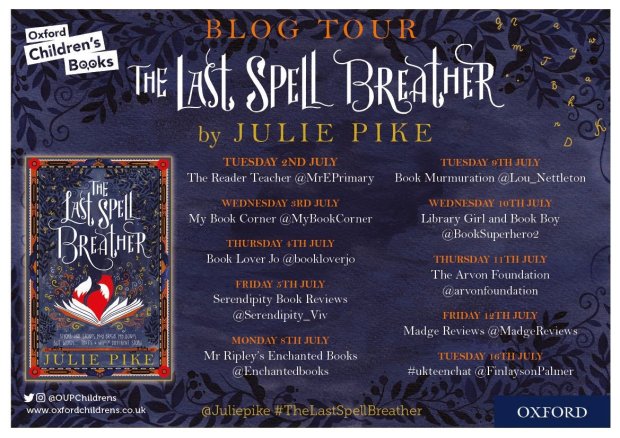
Be sure to check out the rest of the The Last Spell Breather blog tour for more exclusive guest posts from Julie, content & reviews from these brilliant book bloggers!











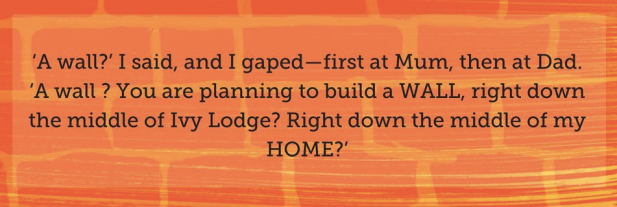
 Review:
Review:


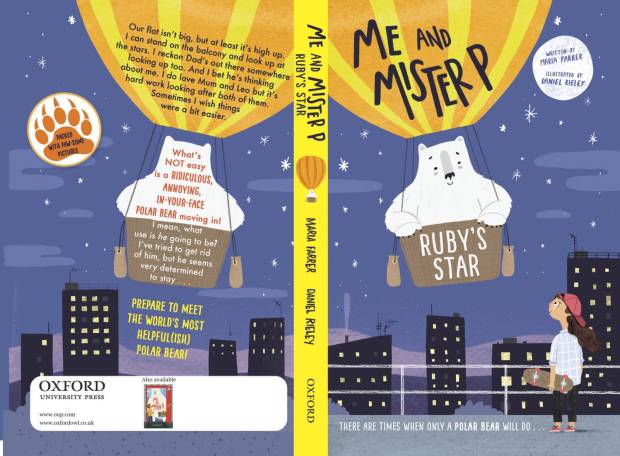

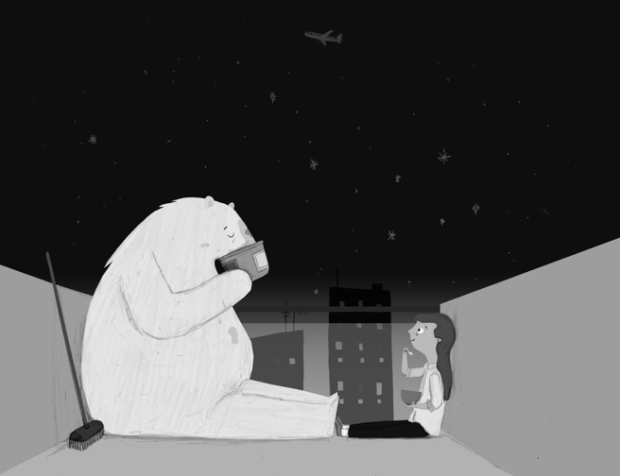 (Illustration by Daniel Rieley)
(Illustration by Daniel Rieley) (Illustration by Daniel Rieley)
(Illustration by Daniel Rieley)


